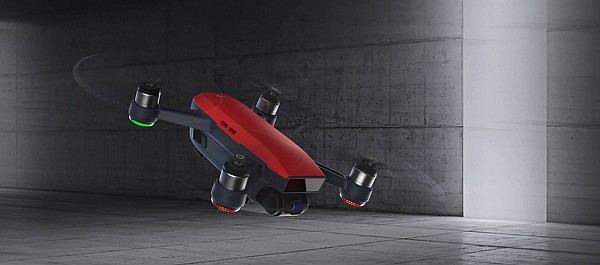Podcast: Play in new window | Download (Duration: 34:04 — 23.5MB)
Subscribe: Google Podcasts | Email | RSS
The DJI Spark, Snap Inc. interest in drones, the ANSI UAS Standardization Collaborative, the Drone Federalism Act of 2017, Florida utility company using drones, the MQ-25A Stingray carrier-launched unmanned tanker, a drone camp for girls, and NATE embraces drones.
UAV News
DJI brings gesture control to consumer drones with the diminutive Spark
The $499 DJI Spark mini-drone recognizes your face and launches and lands on the palm of your hand. It can be controlled with hand movements, a remote controller, a mobile device, or DJI goggles. Featuring obstacle detection and image stabilization, the Spark can follow flight maneuvers preset with your mobile device. It can also follow you.
Snap recently acquired Ctrl Me Robotics, an LA-based drone company

Snap Spectacles. Image courtesy Snap, Inc.
Is the company that owns Snapchat getting into the drone business? It’s unclear, but Snap Inc. acquired drone company Ctrl Me Robotics last year and has reportedly looked at another company in that space.
Last September, Snapchat said it was rebranding itself as a camera company and getting into hardware. Snap also manufacturers a wearable camera called Spectacles. These “smartglasses” record video and connect to your Snapchat account.
ANSI Establishes Unmanned Aircraft Systems Standardization Collaborative
The American National Standards Institute (ANSI) is a private non-profit organization that oversees the development of voluntary consensus standards. ANSI has decided to form a “Standardization Collaborative” for UAS. The Unmanned Aircraft Systems (UAS) Standardization Collaborative (UASSC) will create standards and conformity assessment programs for facilitating the safe integration of UAS into the United States national airspace system (NAS). An initial kick-off meeting is planned for the third quarter of 2017. To stay up-to-date regarding future developments, email Jim McCabe, ANSI senior director, standards facilitation, at jmccabe@ansi.org.
Drone Federalism Act Would Bring Regulation to Local Level
The Drone Federalism Act of 2017 has been proposed by U.S. Senators Dianne Feinstein, D-Calif.; Mike Lee, R-Utah; Richard Blumenthal, D-Conn.; and Tom Cotton, R-Ark. The Act is an attempt to bring UAS regulation down to the local level.
Feinstein says the bill “allows communities to create low-altitude speed limits, local no-drone zones or rules that are appropriate to their own circumstances.”
Blumenthal says, “This legislation protects the rights of state and local governments to implement reasonable restrictions on drones in their communities while ensuring that the Federal Aviation Administration keeps our national airspace the safest in the world.”
So how does it work?
- Keeps the FAA’s “general authority over the national airspace while preserving the authority of state, local and tribal governments to issue reasonable restrictions on the time, manner and place of drone operations within 200 feet of the ground or a structure.
- Reaffirms that the federal government “will respect private property rights to the airspace immediately above a property, including the first 200 feet.”
- Directs the FAA “to partner with a diverse group of cities and states to test out different approaches, inform the unmanned traffic management pilot program and report best practices.”
See Drone Federalism Act of 2017 (Senate Bill 1272) by Jonathan Rupprecht for a quick summary of important facts of the Drone Federalism Act of 2017, problems with the Drone Federalism Act of 2017, who supports it, and the actual text of the Drone Federalism Act.
Florida Utility Preps for Drone Use Ahead of Storm Season
With hurricane season coming soon, Florida Power & Light Company (FPL) is being proactive. They’ve trained more than 1,200 employees and that training includes the use of unmanned aircraft. FPL demonstrated the use of UAS for surveying damage areas and how they can speed up restoration efforts.
Navy to Launch MQ-25 Stingray Refueling Drone Competition This Summer
The MQ-25A Stingray is a carrier-launched tanker designed to extend the combat range of carrier aircraft like the F/A-18 Super Hornet and F-35C Joint Strike Fighter. The Navy is starting an industry competition for the Stingray, which it plans to enter carrier deck service in the early to mid-2020s. In advance of the formal proposal to industry this summer, the Navy awarded four development contracts: Boeing, Lockheed Martin, General Atomics, and Northrop Grumman.
Mentioned
UND to host drone camp for girls
The UAS Camp is sponsored by the Women’s Fund from the Grand Forks Community Foundation. Girls ages 8 to 12 will learn about drones, with hands-on experience with small unmanned aircraft. The camp will take place in two sessions at Robin Hall: from July 31 through Aug. 4 and from Aug. 7 through 11, 2017. Registration is $20 and space is limited. For more information, call Amanda Brandt with the UND College of Aerospace at (701) 732-0592.
Video of the Week
NATE UAS Operations Climber Connection Drone Video
The National Association of Tower Erectors (NATE) “has proactively embraced the utilization of drones in the wireless and broadcast infrastructure industries due to the enormous safety and efficiency benefits associated with their use.” Their new Climber Connection Unmanned Aerial Systems video was distributed industry-wide at the 2017 Drone Focus Conference in Fargo, North Dakota.

